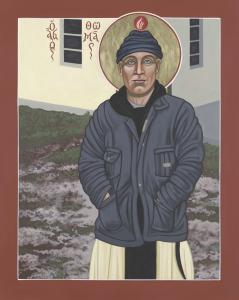Sale on canvas prints! Use code ABCXYZ at checkout for a special discount!

Holy World Evangelist Thomas Merton
by John D. Dadosky
Thomas Merton (1915–1968) was perhaps
one of the most charismatic and complex
personalities in American Catholicism during
the past century. Since his unexpected death in
1968, his influence has grown increasingly among
Christians and members of other religions.
Recently the one hundredth anniversary of his
birth was celebrated.
Throughout his life, Merton was starved for
the feminine. His mother died when he was
young, and there were few women directly in his
life, especially after he entered the monastery at
age twenty-seven. Five years before he met the
nurse with whom he would have an illicit affair, a
prose poem titled “Hagia Sophia” all but prophesizes
their relationship.
Reflecting on this icon the theologian Christopher
Pramuk states,
It seems to me that Bill’s icon beautifully
reflects Merton’s witness as a marginal person,
standing at the margins, standing on his own
feet. Yet Merton’s gaze, perfectly at home outside
his hermitage, is not that of a rugged loner,
indifferent to his visitor. His gaze welcomes and
invites me in. It is She, Sophia, who welcomes
and invites me in: the divine Wisdom-child, the
Holy Spirit of Life, in flame dancing playfully
over Merton’s head. She and Merton are one,
and we are three, encircling in time and space
like Rublev’s Trinity. I am at peace.3
My oldest sister, Anne Cahill, is a big fan of
Merton and has always felt a special connection
with him. It is a kinship we share, and so I was
delighted when she commissioned this icon
of Merton from Bill. The icon depicts Merton
standing outside of his hermitage in Gethsemane,
Kentucky. He was a pioneer in many ways but
especially in that he was the first one to convince
the Trappist monks in the United States to allow
hermits. The image was inspired by a photograph.
He wears a hat with a coat over his Trappist’s
habit that depicts how he brought his own
uniqueness and creativity to his vocation. The
flame suggests that he was led by the Holy Spirit
and that we have something to learn from his life,
writings, and example.
There is a tendency of scholars and religious
leaders in the West to become preoccupied with
Merton’s personal “failings” as a monk. However,
it is interesting to contrast this with the attitudes
of the Eastern monks, who often intuitively
sensed the depth of his spiritual insight. One of
those monks of great stature and repute, upon
meeting Merton for the first time, referred to him
as a “naturally risen Buddha.